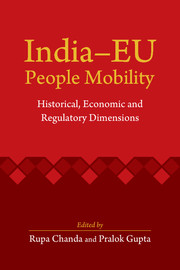Book contents
- Frontmatter
- Dedication
- Contents
- List of Tables, Figures and Boxes
- List of Abbreviations
- Preface
- Acknowledgements
- 1 India–EU People Mobility: Present Status and Policy Perspective
- 2 Economic Linkages and India–EU Mobility
- 3 Indian Diaspora in the EU
- 4 Goans in Portugal: History, Identity and Diaspora Linkages
- 5 Facilitating India–EU Mobility of IT Professionals
- 6 Movement of Indian Architects and Engineers: Prospects and Challenges in the EU
- 7 Mobility of Indian Legal Professionals to the EU: Understanding the EU's Regulatory Regime
- 8 Exploring India–EU Student Mobility
- 9 The Way Forward to a Strategic Engagement
- Contributors
- Index
1 - India–EU People Mobility: Present Status and Policy Perspective
Published online by Cambridge University Press: 05 January 2016
- Frontmatter
- Dedication
- Contents
- List of Tables, Figures and Boxes
- List of Abbreviations
- Preface
- Acknowledgements
- 1 India–EU People Mobility: Present Status and Policy Perspective
- 2 Economic Linkages and India–EU Mobility
- 3 Indian Diaspora in the EU
- 4 Goans in Portugal: History, Identity and Diaspora Linkages
- 5 Facilitating India–EU Mobility of IT Professionals
- 6 Movement of Indian Architects and Engineers: Prospects and Challenges in the EU
- 7 Mobility of Indian Legal Professionals to the EU: Understanding the EU's Regulatory Regime
- 8 Exploring India–EU Student Mobility
- 9 The Way Forward to a Strategic Engagement
- Contributors
- Index
Summary
Introduction
Emigration from India has expanded over the years, not only in terms of the number of emigrants but also in terms of the pathways used to migrate overseas, including irregular migration. Hundreds of thousands of Indians emigrate every year to the developed countries in search of better quality of life and higher income (Subramanian, 2001; Dutta-Sachdeva and Baruah, 2001). The main pull factors are better work opportunities and relatively better pay and work conditions. According to Nangia and Saha (2001), the charm of foreign jobs is so compelling that many of the aspiring emigrants, who could not get genuine work permits, adopt illegal means to go abroad.
Immigration has also become an increasingly important phenomenon in the European Union (EU) and global migration to the EU has expanded significantly since the 1990s. As per a 2006 report of the Director General for Economic and Financial Affairs, European Commission (EC), the average annual net entries for the EU-25 have more than tripled from 198,000 people per annum in the 1980s to around 750,000 persons per annum in the 1990s.1 Immigration has also contributed to employment growth in the EU and is being seen as an important tool to resolve domestic labour shortages in many of the EU Member States (EMN, 2011). However, migration from India to the EU has so far not been significant except in the case of a few Member States, such as the UK, and Italy and in a few sectors, such as IT, health services, dairy and agriculture. Nonetheless, a growing number of Indians are emigrating to the EU and the governments on both sides are looking at facilitating migration between the two regions. In this context, the emigration policies of the Indian government and the policy orientation of the EU governments towards Indian migration assume importance, not only in deciding the quantum of Indian emigrants going to the EU, but also in choosing their destination country within the EU. Policy facilitation is also important for preventing exploitation of Indian emigrants both before and after leaving India.
- Type
- Chapter
- Information
- India–EU People MobilityHistorical, Economic and Regulatory Dimensions, pp. 1 - 27Publisher: Cambridge University PressPrint publication year: 2015

